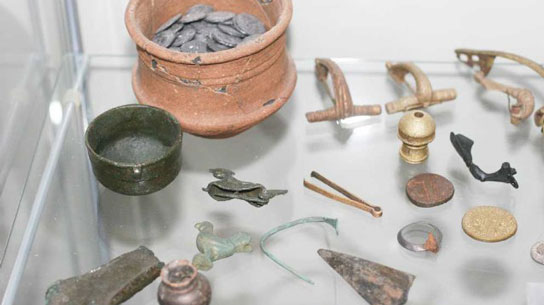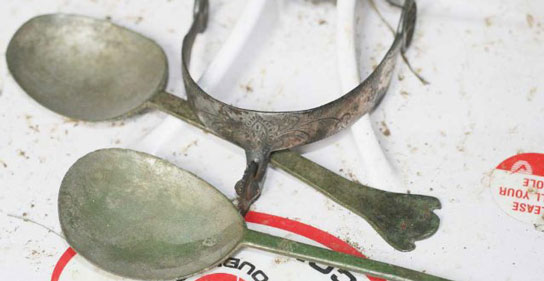In this blog, I want to cover timing choices when searching ancient sites in Europe for Roman and medieval coins.
The best of these sites will have the worse soil conditions, highly mineralised with masses of iron nail contamination. In these conditions it is essential to have the ability to discriminate iron. The GPX 4800 and GPX 5000 can handle these conditions well, but it’s essential you choose the correct coil and timing for the soil conditions.
Site type 1 – highly mineralised
When the mineralisation is really bad, non GPX detectors will rarely get depths of more than 8cm on a 1cm diameter Roman bronze coin. The GPX 4800 and GPX 5000 will excel in dealing with soils with this level of mineralisation. These detectors simply cut through the mineralisation, punching deeper than any VLF detector on the market.
The best timings for these levels of mineralisation are from the Smooth timings family. These timings where developed for the highly mineralised gold prospecting areas of the world.
Enhanced and Fine Gold (GPX 5000 only) are my preferred timings for highly mineralised sites. These timings will give reasonable depth to all target sizes. They will also be able to maximise the discrimination feature of the GPX detectors, allowing users to discriminate most iron targets encountered.

Site type 2 – medium mineralisation
Some Roman and most Medieval sites have less iron and mineralisation. On these sites Enhanced still works well, but deep thin section hammered silver coins deeper than 18cm will not be detectable. Up to 18cm (using Enhance) on a medieval penny (Sterling) is still a good depth compared to non-GPX detectors, but not to the true depth potential of a Minelab GPX detector.
Switching the timing to Normal or Sensitive Extra will increase the detection depth on small hammered coins by up to 50%.
The Normal timing also gives greater depth on larger targets like Roman brooches or post-medieval Crotal bells.
Switching the standard 11” coil for a Commander 15x12 Double-D coil will increase the depth advantage even further in medium mineralisation.
Site type 3 – low mineralisation
The third type of soil type is totally benign, with little or no mineralisation. These sites will usually have low levels of iron contamination, as they tend to be away from sites of constant habitation. Long-term pastureland can also fall into this type where the soil build-ups have low mineralisation characteristics.
Most VLF detectors can detect to good depths, and the best of them are the ones using large coils with good sensitivity.
If you use a GPX fitted with a standard coil on benign soils, and compare it against the best of the VLF competition, you will only see a very modest depth advantage.
Switch to a Commander 15x12 Double-D or the 18” Double-D coil, and depth attainable will increase exponentially. If the iron content of the soil is minimal, it can be worth switching to a Monoloop coil, which will step-up the depth performance further still.
For low mineralised soils there are several dedicated timings. Sharp timing is probably the best for finding deep small hammered coins. Coin/Relic is great for finding larger items like cannonballs on old battle fields, but isn’t the best choice for finding thin section finds like hammered coins. Coin/Relic is the most powerful timing, but doesn’t handle mineralisation like other timings, so can be very difficult to stabilise on all but the most benign soils. Normal timing is also a good choice and my personal favourite.

Conclusion
So that’s all soil types pigeonholed into three categories…. If only life was that simple! Even if you do find a soil type that doesn’t conform to these types, you should find a timing that will excel for your soil conditions.
Now go out and find something!
Gordon Heritage




















Comments
I often read about relic and coin hunting in Europe compared to the US, where the European detectorists use all metal mode on their detectors a lot of the time because they want to investigate everything in the ground and not discriminate anything out in case it is a good find not just ferrous metal.
My question is this; why not use the "Smooth Class of timings" with the coils they are designed for instead of using a DD coil, which could cost you a lot of performance? As an example a DD coil in Fine Gold mode will not come anywhere near the depth of a similar sized Monoloop especially on those fast time constant targets you mention in your blog.
Might I suggest for depth similar to what you have described above with the larger DD coils, you could easily achieve the same with the smaller Commander monoloops in the Minelab coil line up? As an example the 8" Commander mono will easily match or even exceed the performance of the larger 15x12 DD Commander coil with added sensitivity to the fast time constant Gold and Silver items in the ground.
If the ferrous targets are thick in the area then the smaller coil will help by being able to maneuver between the ferrous junk, if the sensitivity is too high then you have three timings to choose from which will effectively iron out a lot of the rusty iron signals, as an example the Smooth class of timings do a very good job of this without compromising too much on depth or at least no where near as much as the DD/smooth class timing combination will.
The Smooth type timings are designed to ignore mineralisation, in doing so they also do a very good job of ignoring very rusted ferrous items that would normally swamp the detector if used in non-smooth type timings such as Normal or Sens Xtra. Combining these timings with a DD coil will only cut back even more on performance due to the DD coil also ignoring a lot of ground signal.
If discrimination is absolutely needed then obviously a DD coil is required, however there is a lot of performance available with the use of a monoloop coil, in my view using the timings to deal with ferrous clutter whilst still maintaining performance is quite possible.
Regards,
Jonathan
Yes here in Europe we do tend to run less discrimination than they do in the US, as a lot of our best targets sit around the foil area of the discrimination scale. On FBS detectors like the E-TRAC we add minimal discrimination, or (as you rightly state) search in all-metal. This is to prevent good non-ferrous targets being lost in the iron-nulls of any nearby iron. Although this method is generally referred to as "all metal", it isn't really as it's easy to hear the difference between ferrous and non-ferrous metals. True all-metal detectors gives the same audio response from all metals.
My first GPX was the GPX-4000 which I used to recover stray gold Staters from an old hoard site in Buckinghamshire, England. This site would fall into my "Site type 3" low mineralisation soil example. When detecting with the standard DD coil, I soon realised I needed more performance, so switched to a large mono. This coil (the Commander 18") punched deeper than any detector I had previously owned, even once giving a solid signal on an "on edge" gold coin at 14". Some of the larger iron was easy to suss, but the only reliable method to fully deal with the nails was to mark the position of the signals, and then only dig the targets my EXPLORER SE couldn't hear (or had discriminated).
So without doubt it took a mono coil to release the full-power of my GPX-4000 on this site.
Since receiving my GPX 4800, I have tried to respond to users who have wanted to "blank" discriminate iron. And this blog was intended to get new users off the ground. Even though the standard DD coil isn't releasing the full potential of the GPX 4800 when using a "smooth type" timing, it's still getting phenomenal depth increases in highly mineralised soils when compared to other top detectors. Iron in the UK is a real problem, and I would love to take you on some of my Roman sites so you could experience it.
I have an 8" mono coil (new still in the box), so will give it a try! It would be great to reliably discriminate iron without blanking, as experience has shown me what else is being missed in those nulls. I'll let you know how I get on.
Thanks again Jonathan for your thoughts.
Gordon Heritage